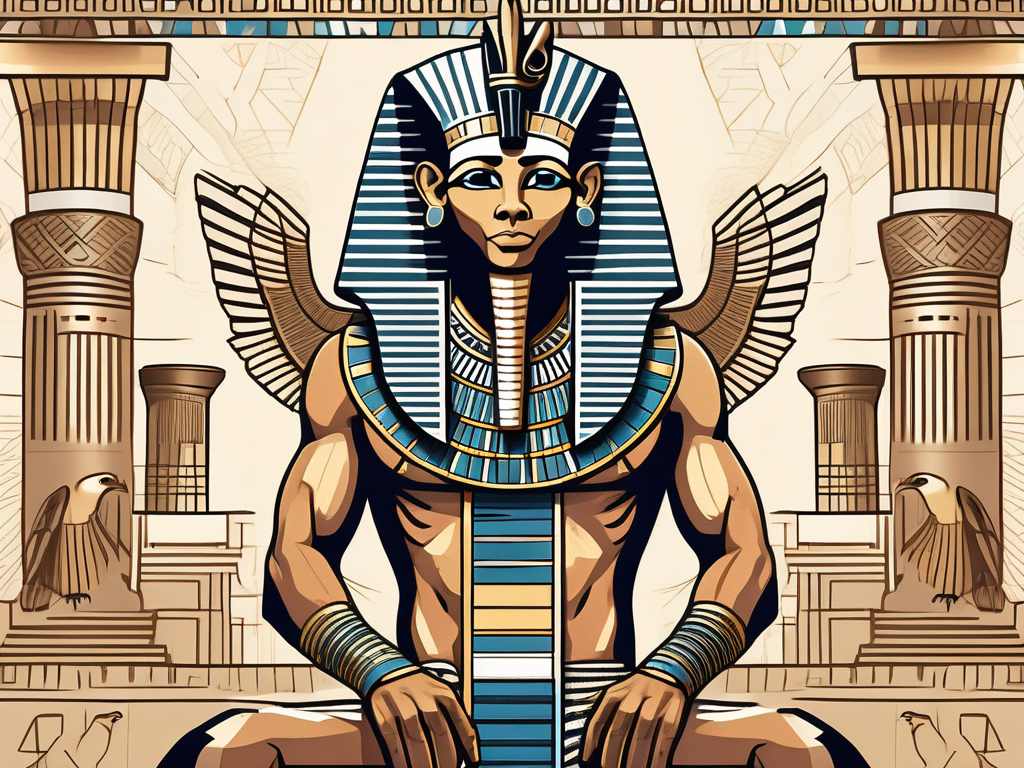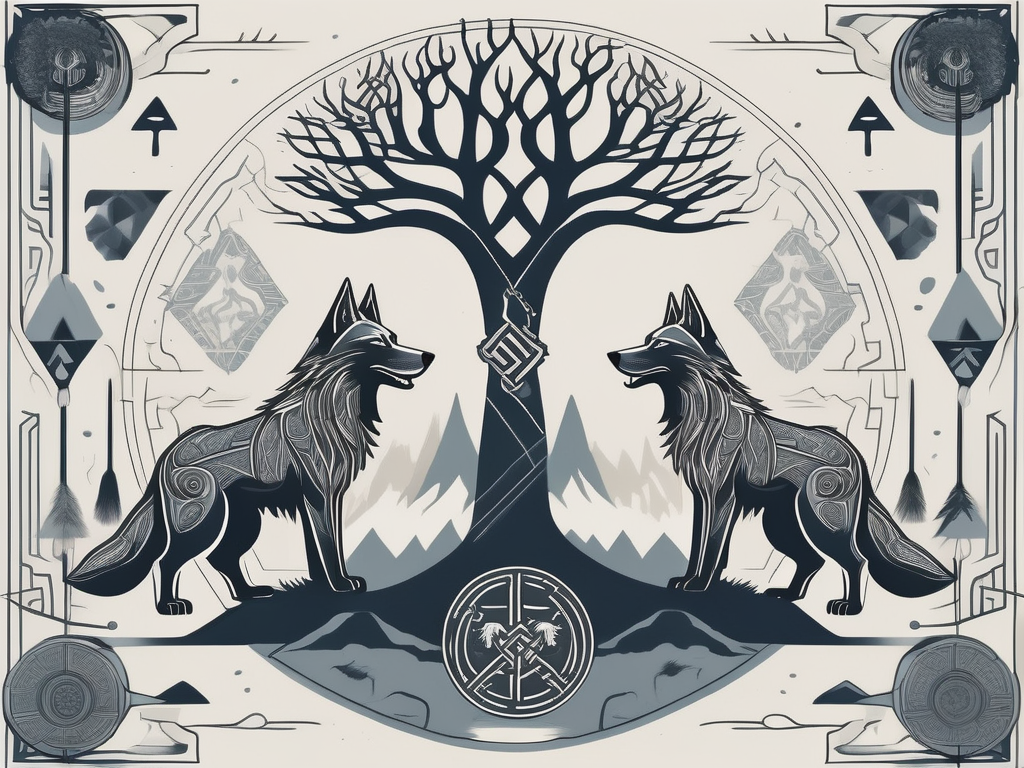In the rich tapestry of ancient Egyptian mythology, there is a deity that stands out with its unique and captivating appearance – the deity with a dog head. This intriguing creature holds a special place in the hearts of Egyptologists and those fascinated by ancient civilizations. Let’s dive deeper into the symbolism behind the dog-headed deity and unravel its mysteries.
Understanding the Symbolism of the Dog Head
Animals played an essential role in ancient Egyptian mythology, often representing various aspects of life and the divine. The dog, in particular, held significant symbolism. Egyptians believed that the dog was a loyal and protective creature, capable of guarding and guiding souls on their journey through the afterlife.
The dog-headed deity, therefore, embodied these attributes and became a symbol of protection, death, and rebirth. Its presence in Egyptian mythology highlights the intricate beliefs and customs surrounding life, death, and the beyond.
The Role of Animals in Egyptian Mythology
The ancient Egyptians revered animals and incorporated them into different aspects of their daily lives. Animals were believed to possess unique traits and qualities, making them powerful symbols in religious and spiritual contexts. From the majestic lion to the graceful ibis, each animal held a specific meaning and represented different deities.
For example, the lion symbolized strength and royalty, associated with the powerful sun god, Ra. The ibis, on the other hand, represented wisdom and knowledge, linked to the god of writing and scribes, Thoth. These animal-headed deities fulfilled a variety of roles, such as guardians, guides, and judges. They were worshipped and sought for protection and assistance, ensuring harmony and balance in the world of the living and the realm of the dead.
Depictions of animals in Egyptian art and hieroglyphs were not merely decorative but held deep symbolic meaning. They were a way for the ancient Egyptians to connect with the divine and understand their place in the universe.
The Significance of the Dog in Ancient Egypt
The dog, known as “iwiw” in ancient Egyptian, held a special place in the hearts of the Egyptians. They were often depicted alongside their human counterparts, serving as loyal companions and protectors in both life and death. The dog’s role extended beyond the physical realm, delving into the spiritual and religious aspects of Egyptian culture.
Ancient texts and inscriptions mention the dog’s association with specific deities, reinforcing their importance in divine rituals and mythological narratives. One such deity is Anubis, the god of embalming and the afterlife, who is often depicted with the head of a jackal or a dog. Anubis guided souls through the perilous journey of the afterlife, ensuring their safe passage to the judgment hall of Osiris, the god of the dead.
The dog’s loyalty and protective nature made it an ideal companion for individuals seeking divine assistance and protection. In the realm of the afterlife, the dog-headed deity would guard and guide souls, ensuring their safe transition to the eternal realm.
Furthermore, the dog’s association with death and rebirth is evident in its presence in tomb paintings and burial sites. These depictions serve as a reminder of the dog’s role in the journey to the afterlife and the belief in the cyclical nature of existence.
In conclusion, the symbolism of the dog head in ancient Egyptian mythology represents loyalty, protection, death, and rebirth. It reflects the intricate beliefs and customs surrounding life, death, and the afterlife in Egyptian culture. The dog’s association with specific deities and its presence in religious rituals and burial practices further emphasize its significance in the spiritual and divine realms.
Anubis: The Dog-Headed God of the Underworld
One of the most iconic and well-known dog-headed deities in ancient Egypt is Anubis. With a jackal-headed appearance, Anubis played a prominent role in Egyptian mythology and funerary practices. Let’s explore the captivating mythology surrounding this enigmatic figure.
Anubis, also known as Inpu or Anpu, was believed to be the son of Osiris, the god of the afterlife, and Nephthys, a protective goddess. As the jackal-headed god of embalming and the underworld, Anubis held the vital role of guiding, protecting, and judging the souls of the deceased.
According to ancient Egyptian mythology, Anubis played a crucial part in the weighing of the heart ceremony. This ritual, known as the “Weighing of the Heart,” determined the fate of the deceased’s soul, depending on the purity of their heart. Anubis carefully examined the hearts of the deceased, overseeing the judgment process and ensuring justice prevailed.
But what exactly did this ceremony entail? Let’s delve deeper into the fascinating details. The “Weighing of the Heart” took place in the Hall of Ma’at, the goddess of truth and justice. The deceased’s heart, represented as a feather, was placed on one side of the scales, while the other side held the feather of Ma’at, symbolizing truth and balance. Anubis, with his keen eyes and sharp senses, closely observed the scales, ensuring that the heart was neither heavy with sin nor imbalanced. If the heart was found to be pure, the deceased was granted eternal life in the afterlife. However, if the heart was heavy with wrongdoing, it would be devoured by Ammit, a fearsome creature with the head of a crocodile, the front legs of a lion, and the hind legs of a hippopotamus.
Anubis’ role extended beyond the weighing ceremony. As the god associated with embalming, Anubis was responsible for preserving and safeguarding the bodies of the deceased. Ancient Egyptians believed that proper burial practices were vital for a successful journey into the afterlife.
Let’s take a closer look at the intricate process of mummification. After the body was carefully washed and purified, it was then laid on a sloping embalming table. Anubis, often depicted in funerary texts and tomb paintings, watched over the rituals and assisted in the mummification process. The internal organs were removed and preserved in canopic jars, while the body was packed with natron, a natural salt, to dry it out. Anubis, with his divine presence, ensured that every step was carried out with utmost care and reverence.
Once the body was properly prepared, it was wrapped in linen bandages, sometimes adorned with amulets and charms for protection. Anubis, the guardian of the dead, oversaw the wrapping process, ensuring that the deceased was properly adorned for their journey into the afterlife. The mummified body was then placed in a decorated coffin, ready to be laid to rest in a tomb.
Anubis’ presence provided comfort and protection, allowing the deceased to transition smoothly into the realm of the dead. His watchful eyes and jackal-headed form symbolized his ability to navigate the liminal space between life and death, guiding souls through the treacherous journey to the afterlife.
The Iconography of Anubis
The striking presence of Anubis in ancient Egyptian art is a testament to his significance in their culture and mythology. Let’s delve into the captivating representations of this dog-headed deity and explore their meanings.
Depictions of Anubis in Ancient Art
Ancient Egyptian art beautifully captured the essence of Anubis through intricate and detailed portrayals. Numerous statues and reliefs depict him with the body of a man and the head of a jackal, exuding an aura of authority and power.
Artists paid attention to the symbolism associated with Anubis, presenting him as a figure of protection and guidance. In many depictions, he is shown with his arm extended, guiding and leading the deceased towards the afterlife.
Anubis in Hieroglyphics and Inscriptions
Just as the images of Anubis permeated ancient Egyptian art, so did his presence in hieroglyphics and inscriptions. Hieroglyphic texts carved into tombs and temples often depicted Anubis in scenes of the weighing of the heart ceremony.
These inscriptions served as a reminder of Anubis’ role in the afterlife and offered guidance to the deceased in navigating their spiritual journey. Through the power of the written word, the significance of Anubis was immortalized and preserved for generations to come.
The Worship and Cult of Anubis
Anubis’ compelling mythology and symbolism led to the establishment of a dedicated worship cult. Let’s explore the practices and rituals associated with the veneration of this dog-headed deity.
Temples and Shrines Dedicated to Anubis
Throughout ancient Egypt, temples and shrines were erected to honor Anubis and pay homage to his divine presence. These sacred spaces served as gathering places for worshippers and provided a physical space for religious ceremonies and offerings.
Embellished with vivid wall paintings and intricate reliefs, these religious structures acted as gateways between the mortal realm and the divine. Devotees sought solace and guidance from Anubis, entrusting him with their prayers and petitions.
Rituals and Ceremonies in Honor of Anubis
The cult of Anubis performed various rituals and ceremonies as acts of devotion and reverence. These practices ranged from simple offerings of food and drink to elaborate processions and performances.
During these ceremonies, priests dressed in animal skins, embodying the form of Anubis, and partook in intricate rituals symbolizing the journey of the deceased. The worshippers believed that these rituals would secure the protection and blessings of Anubis, ensuring a smooth transition into the afterlife.
Anubis’ Influence on Modern Culture
The enigmatic allure of Anubis continues to captivate modern culture, leaving an indelible mark on literature, film, and contemporary Egyptology. Let’s explore how this ancient deity resonates with us today.
Anubis in Literature and Film
Throughout the years, numerous authors and filmmakers have been inspired by the gripping mythology surrounding Anubis. He has become a recurring character in various literary works and movies, often depicting his role as a guide and protector in the afterlife.
From thrilling adventure tales to thought-provoking examinations of life and death, Anubis remains a popular figure, continuing to intrigue and fascinate audiences across the globe.
Anubis as a Symbol in Contemporary Egyptology
Within the realm of Egyptology, Anubis serves as a symbol of the deep connection between the ancient Egyptians and their beliefs surrounding death and the afterlife. Scholars and researchers continue to explore and unravel the mysteries surrounding this captivating dog-headed deity.
Through meticulous study of ancient texts, artifacts, and burial sites, Egyptologists strive to gain a deeper understanding of Anubis’ significance and his role in shaping the religious and cultural landscape of ancient Egypt.
In conclusion, the deity with a dog head holds a special place in ancient Egyptian mythology. From its symbolism and mythological narratives to its striking depictions in art and its influence on worship practices, this captivating figure continues to fascinate and enthrall. The dog-headed deity, with Anubis as its most prominent representative, guides us into the mysteries of the afterlife and reminds us of the rich tapestry of beliefs that shaped the ancient Egyptian civilization.












